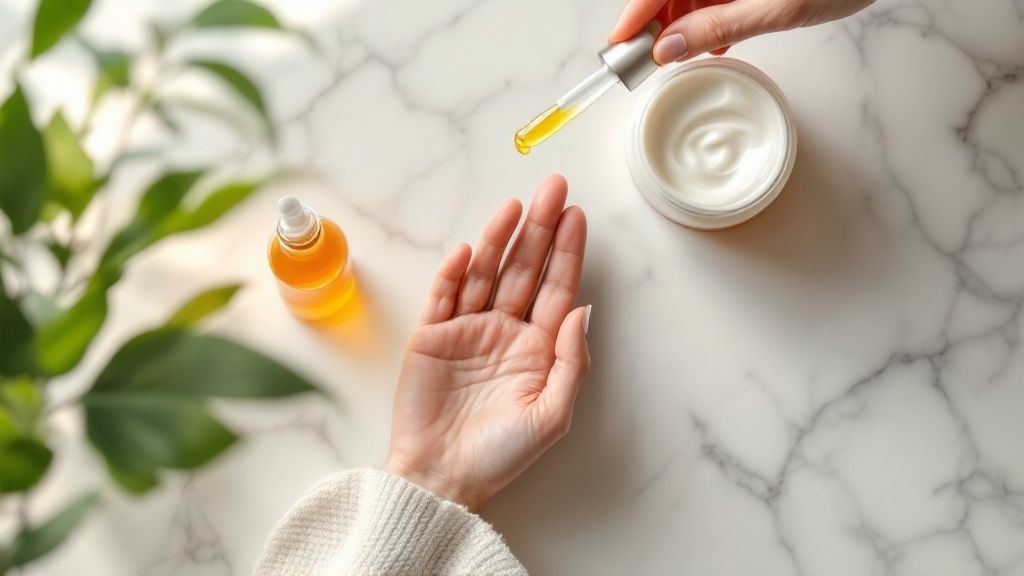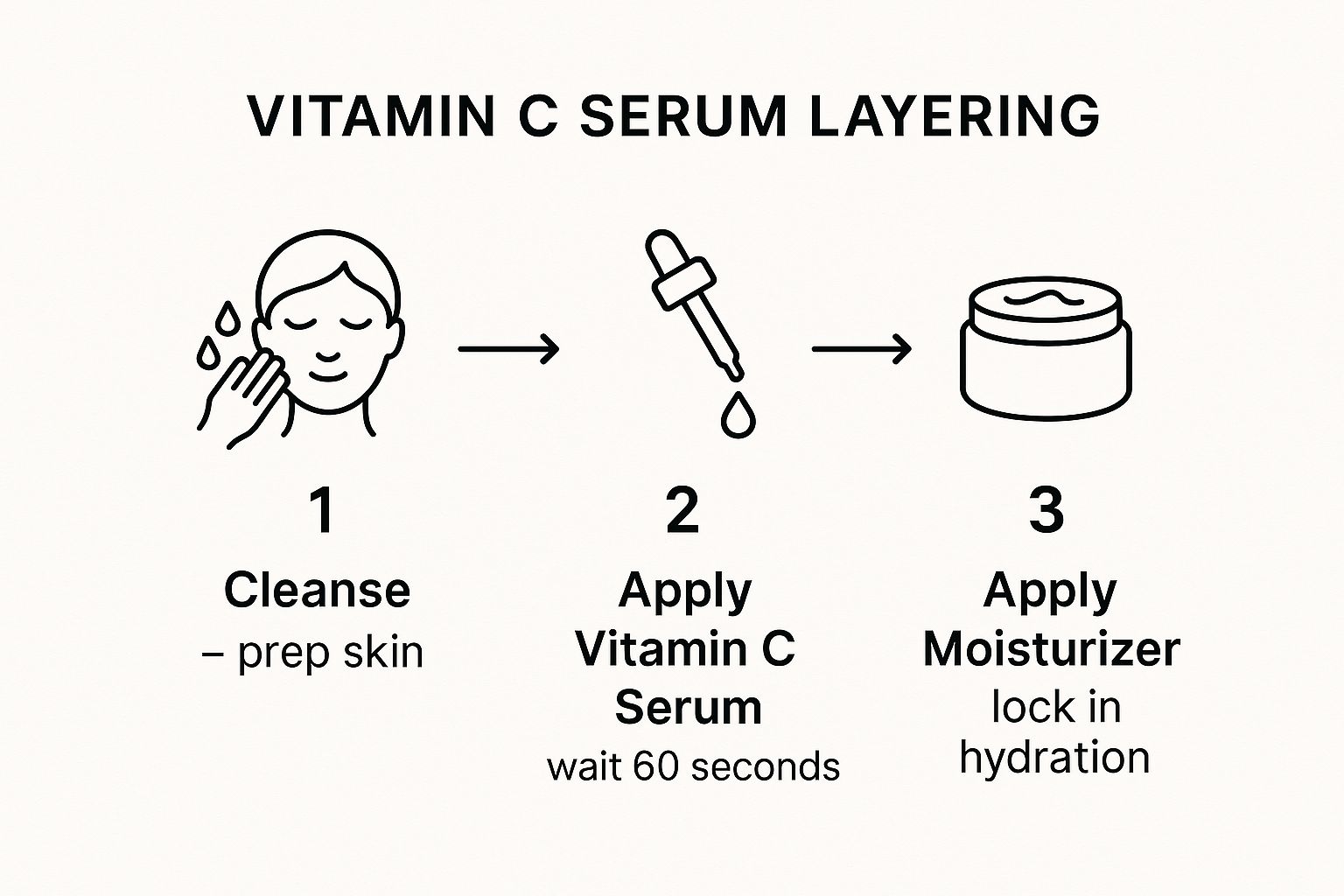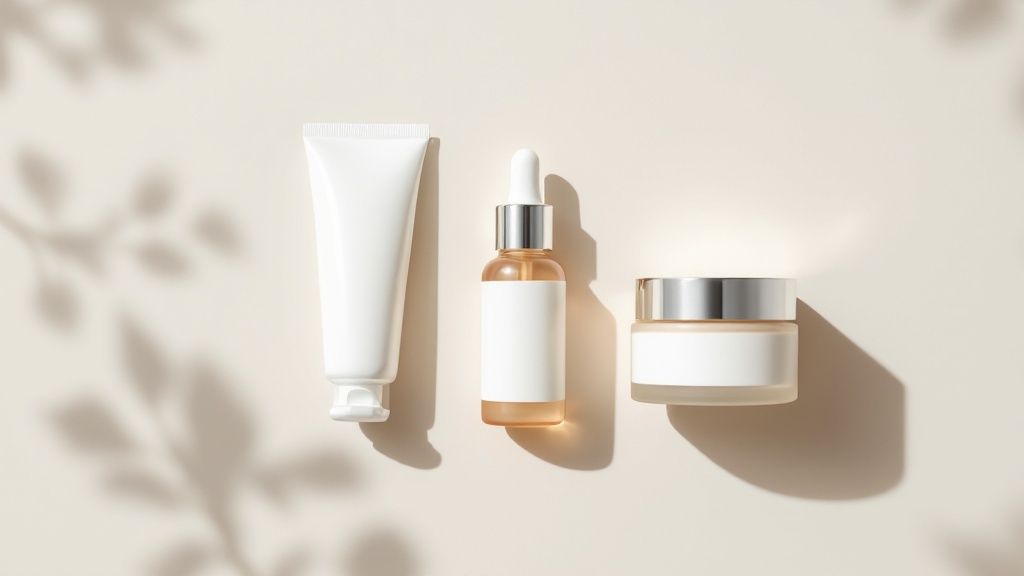
Let’s settle this once and for all: your vitamin C serum always goes on before your moisturizer. Getting this one step right is an absolute game-changer for your skin, making sure you get the full protective and brightening power you paid for.
The Skincare Question That Changes Everything

So, why does this order matter so much? It all comes down to a simple, universally accepted skincare principle: apply your products from the thinnest consistency to the thickest. This isn't just a casual suggestion; it's a rule rooted in how skincare products are actually formulated to work on your skin.
Vitamin C serums are designed to be lightweight, almost watery, with a small molecular structure. Their whole job is to dive deep into the skin's surface to deliver potent antioxidants, fight off environmental damage, and kickstart collagen production. To do that, they need a clear path.
Moisturizers, on the other hand, are much thicker and richer. Their molecules are larger, and their main purpose is to hydrate the skin and lock everything in by creating a protective barrier on the surface.
The Science of Proper Layering
Think of it like painting a wall. You wouldn't put the topcoat of paint on before the primer, would you? The primer (your serum) goes on first to prep the surface. Then, you apply the paint (your moisturizer) to seal and protect it all.
If you slather on a thick moisturizer first, you’re essentially creating a roadblock. That barrier will physically block your lighter, hard-working vitamin C serum from ever reaching your skin cells where it needs to do its job.
This "serum-first" approach is a globally recognized best practice. All the top skincare experts and brands will tell you to apply antioxidant serums directly to clean skin. This lets the vitamin C act as your skin's frontline defense, neutralizing damaging free radicals before they can cause trouble. You can read more about the expert-endorsed skincare layering approach to see why this order is so critical for healthy, glowing skin.
To make it even clearer, here’s a quick breakdown of the key differences and why the "serum first" rule is non-negotiable.
Quick Guide: Vitamin C Serum vs. Moisturizer Application
| Attribute | Vitamin C Serum | Moisturizer |
|---|---|---|
| Purpose | To deliver active ingredients deep into the skin for protection and repair. | To hydrate the skin's surface and create a protective barrier. |
| Consistency | Lightweight, watery, and fast-absorbing. | Thicker, richer, and creamier. |
| Molecular Size | Small, designed for deep penetration. | Large, designed to sit on top of the skin. |
| Application Step | Apply first, directly onto clean, dry skin. | Apply last (before SPF), to lock in the serum and moisture. |
By following this simple rule, you ensure each product can perform its job without interference. It's the secret to maximizing those glow-boosting results you're looking for.
Why The Serum-First Rule Is Non-Negotiable

It’s a question I hear all the time: "Does it really matter if I put my vitamin C on before my moisturizer?" The answer is a resounding yes. Getting the order wrong is one of the most common ways people accidentally sabotage their own skincare results.
The logic is actually pretty simple when you think about what each product is designed to do. Skincare layering all comes down to molecular size and purpose.
Vitamin C serums are formulated to be potent, penetrative treatments. They're packed with tiny, powerful antioxidant molecules that need to get deep into your skin to do their best work—neutralizing free radicals, brightening your complexion, and supporting collagen.
On the other hand, moisturizers are built with much larger molecules. Their primary job isn't to penetrate, but to create a nourishing, protective barrier on the skin's surface. This barrier is fantastic for locking in hydration, but it’s terrible for letting anything else through.
The Science Of Skin Absorption
Putting your moisturizer on first is like trying to water your plants through a plastic tarp. The water (your serum) just pools on top, unable to reach the soil (your skin cells) where it's actually needed. The moisturizer’s barrier effectively blocks the path, rendering your powerful, and often pricey, serum almost completely useless.
By applying your vitamin C serum directly to clean skin, you’re giving its active ingredients a clear, unobstructed path to penetrate the dermal layers. This is how the serum can work at its maximum capacity, delivering the visible brightening and anti-aging effects you’re looking for.
This isn’t just a friendly suggestion; it’s a fundamental principle of cosmetic science. To truly maximize the well-documented vitamin c serum benefits, you have to give it direct access to your skin.
To get the most out of every single drop, just remember this simple distinction:
- Serums are for treatment. They deliver concentrated active ingredients deep into the skin.
- Moisturizers are for protection. They hydrate the surface and seal everything in.
When you honor this order, you ensure both products can perform their unique jobs perfectly. They work together, not against each other, to give you healthier, more radiant skin. It’s the non-negotiable first step to a routine that actually works.
Building Your Ultimate Morning Skincare Routine
Now that you know why the order matters, let's walk through how to put it all together. A truly effective morning routine isn’t about piling on a dozen products; it’s about smart, strategic layering that sets your skin up for success all day long.
Think of it as starting with a clean slate. Your first move should always be a gentle cleanser to wash away oil and impurities from overnight. If you use a toner, swipe it on next to balance your skin’s pH and get it ready for what's coming.
Applying Your Vitamin C Serum
This is where the magic happens. You only need a few drops of your vitamin C serum—a pea-sized amount is perfect. Instead of rubbing it in, gently pat and press the serum onto your face and neck. This technique helps the skin absorb it more effectively without any unnecessary pulling or tugging.
Here’s the single most important tip I can give you: wait. After applying the serum, give it a full 60 to 90 seconds to sink in completely. This pause is crucial. It lets those powerful, small molecules penetrate deep into your skin before you layer anything on top that could dilute them. Your skin should feel dry to the touch, or just slightly tacky, before you move on.
Once your serum has had its moment, it's time to lock in all that goodness with your favorite moisturizer. Applying it right after the vitamin C has absorbed seals in the active ingredients and reinforces your skin's moisture barrier, keeping it healthy and hydrated.
This infographic is a great visual reminder of how simple the layering process is.

It really just comes down to that simple flow: cleanse, treat with vitamin C, then hydrate with moisturizer. Following this order ensures every product can do its job properly.
The Non-Negotiable Final Step
And finally, we get to the one step you can never, ever skip in the morning: sun protection. A broad-spectrum sunscreen isn’t just an add-on; it’s the ultimate partner for your vitamin C serum.
The serum works from within to neutralize free radicals that your SPF might miss, while the sunscreen acts as a powerful shield against UV rays. They are the ultimate dynamic duo for daytime defense. This combo is truly your best defense against premature aging and daily environmental damage.
How To Choose The Right Vitamin C Serum

Let's be honest, not all vitamin C serums are created equal. Walking into the world of active ingredients can feel overwhelming, but understanding the basics makes all the difference—especially when you’re figuring out whether to use your vitamin C serum before or after moisturizer.
The most powerful, well-researched form you'll see is L-ascorbic acid. It's a fantastic choice if you have resilient skin and want maximum impact on brightness and collagen. But that power comes with a trade-off; its low pH can sometimes be a bit much for sensitive skin types.
That's where the gentler derivatives come into play. Ingredients like Sodium Ascorbyl Phosphate or Tetrahexyldecyl Ascorbate are much more stable and way less likely to cause irritation, making them a perfect starting point for beginners or anyone with reactive skin.
Finding The Perfect Balance Of Potency And Gentleness
Concentration matters, too. While a 20% formula might sound like the best option, serums between 10% and 15% often hit that sweet spot of effectiveness and tolerability for most people. It’s always smart to start a little lower and let your skin get used to it.
For anyone looking for a high-performance serum that still respects the skin barrier, we wholeheartedly recommend the BARB N.P. Vitamin C Serum. It’s been expertly formulated to be both potent and gentle, giving you all those powerful antioxidant benefits without the irritation that often comes with pure L-ascorbic acid. Its stable formula also means it stays effective from the very first drop to the last.
The BARB N.P. Vitamin C Serum also includes soothing ingredients that help calm the skin, making it an excellent choice for daily use. It provides the visible brightening and protective results you want, in a formula your skin will love.
Picking the right product from the start ensures you get all the glow without any of the drama. While there are many great options out there, it's worth exploring why certain brands, like SkinCeuticals, are often considered the gold standard for glowing skin. Understanding what makes a premium formula stand out can help you make the best choice for your own routine.
Take Your Results to the Next Level with Skincare Tech
So you’ve nailed your vitamin C and moisturizer routine. Your skin is looking brighter, feeling more hydrated, and you’re starting to see that consistent glow. What's the next step for someone who wants to amplify those results?
If you're ready to move beyond just topicals and into professional-grade treatments at home, it’s time to look at skincare technology. One of the smartest investments you can make is in an LED (light-emitting diode) therapy device.
LED therapy is a science-backed treatment that uses different wavelengths of light to spark real change at a cellular level. It’s fantastic for everything from calming inflammation and killing acne bacteria to kick-starting collagen production for firmer, younger-looking skin. Think of it as a powerful ally to your vitamin C serum—while the serum provides antioxidant defense, LED therapy works on different pathways to achieve total skin health.
Meet The BARB N.P. Facial Mask
For those who are serious about investing in their skin, my top recommendation is the BARB N.P. Facial Mask. This isn't just another gadget; it's a tool designed to deliver clinic-level results without making you put your life on hold.
Its best feature? It's completely wireless. You can pop it on and keep going with your day—answer emails, tidy up, or just relax on the couch. It’s also designed with comfort in mind, so the mask rests easily on your face without feeling heavy or slipping during a treatment.
The real magic is in its targeted light settings. With 3 lighting settings for different treatments, it’s like having a multi-functional skin clinic right in your own home, ready to work in sync with your favorite products.
The BARB N.P. Facial Mask gives you three powerful treatments in one device:
- Red Light: This is your anti-aging powerhouse. It dives deep to wake up your fibroblasts, the tiny factories that produce collagen and elastin. The result? A visible reduction in fine lines and a boost in skin firmness.
- Blue Light: Perfect for anyone dealing with breakouts. This wavelength targets and destroys acne-causing bacteria right on the skin’s surface, helping clear up current blemishes and stop new ones from forming.
- Amber Light: Consider this your calming, restorative light. It’s brilliant for reducing redness, soothing inflammation, and promoting a more even, balanced skin tone. It’s a lifesaver for sensitive or irritated skin.
When you add this mask to your weekly routine, you’re doing more than just applying products. You’re supercharging their performance for results you can truly see and feel.
Your Top Vitamin C Questions, Answered
Let's clear up some of the most common questions I hear about vitamin C. Getting these small details right is what separates a good skincare routine from a great one, especially when it comes to the vitamin C serum before or after moisturizer debate. This is your final cheat sheet for getting it perfect.
Can I Use Vitamin C Serum At Night?
One of the biggest questions is whether vitamin C is effective at night. While you can use it then, you’d be missing out on its greatest superpower: daytime protection.
Think of it as your skin's personal bodyguard. During the day, it works overtime to shield your skin from UV damage and environmental aggressors like pollution. Applying it in the morning right before your sunscreen creates an incredible defensive layer that’s simply not needed while you sleep.
Save your nighttime routine for repair-focused ingredients. This is the prime time for actives like retinoids or hydrating acids that work best while your skin is in its natural repair cycle, away from the sun. Honestly, the morning is vitamin C’s time to shine.
How Long Should I Wait Between My Serum and Moisturizer?
Timing is everything. After applying your vitamin C, you absolutely need to wait 60 to 90 seconds before layering on your moisturizer.
This short pause is non-negotiable. It gives the potent, small molecules in the serum enough time to fully penetrate your skin without being diluted or blocked by your moisturizer. You'll know it's ready for the next step when your skin no longer feels tacky to the touch.
What Happens If I Apply Moisturizer First?
If you apply moisturizer before your vitamin C serum, you're essentially wasting a fantastic product. Moisturizers are designed to create a barrier on your skin's surface, and their molecules are much larger than those in a serum.
This barrier physically blocks the smaller serum molecules from reaching the deeper layers of your skin where all the brightening and protective magic happens. You’ll get almost none of the benefits.
A Final Pro Tip: For maximum impact, always apply your vitamin C serum to completely dry skin. After cleansing and toning, gently pat your face dry. Applying a potent serum like L-ascorbic acid to damp skin can sometimes alter its pH, which may lead to irritation or reduce its stability and power.
Perfecting these little details ensures every single drop of your serum works as hard as it possibly can for your skin.
Ready to take your skincare routine to the next level? The BotoxBarb team recommends pairing your vitamin C serum with the BARB N.P. Facial Mask to supercharge your results. Explore this and other medical-grade skincare essentials.

